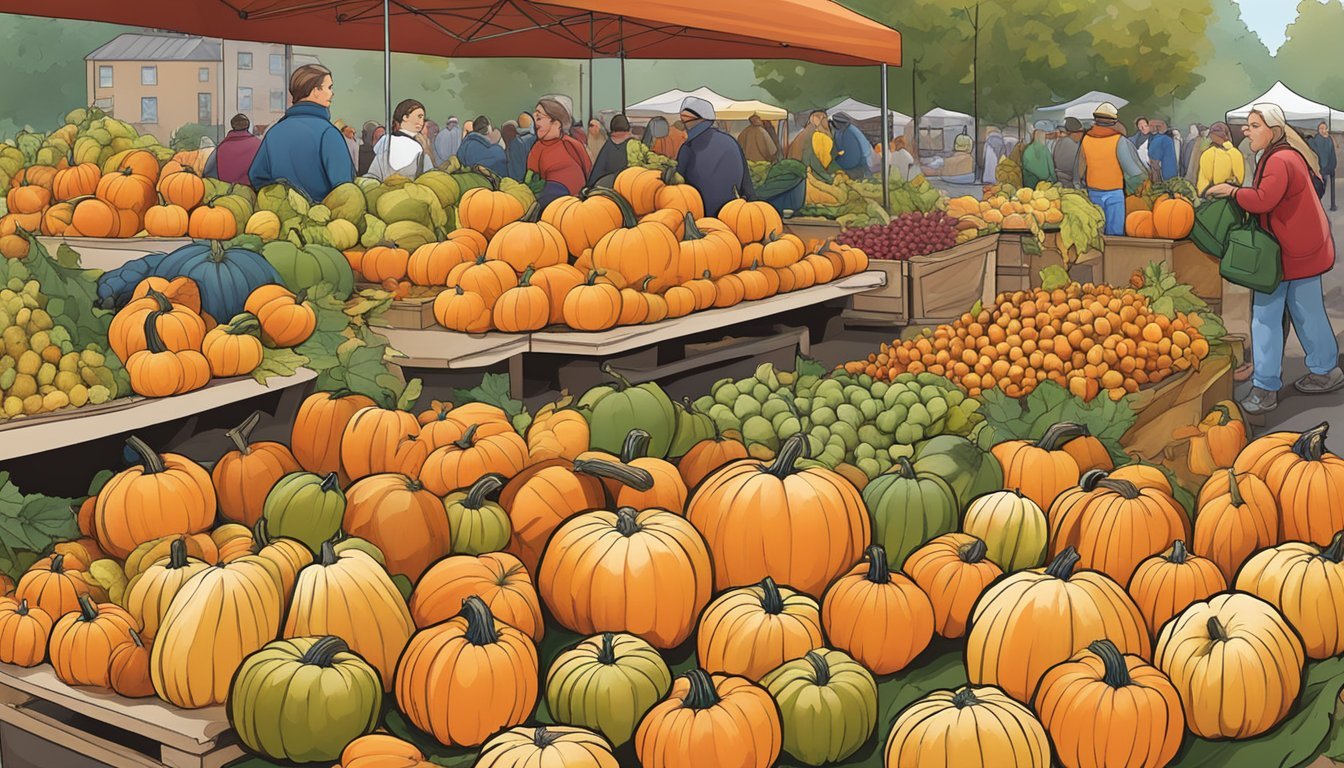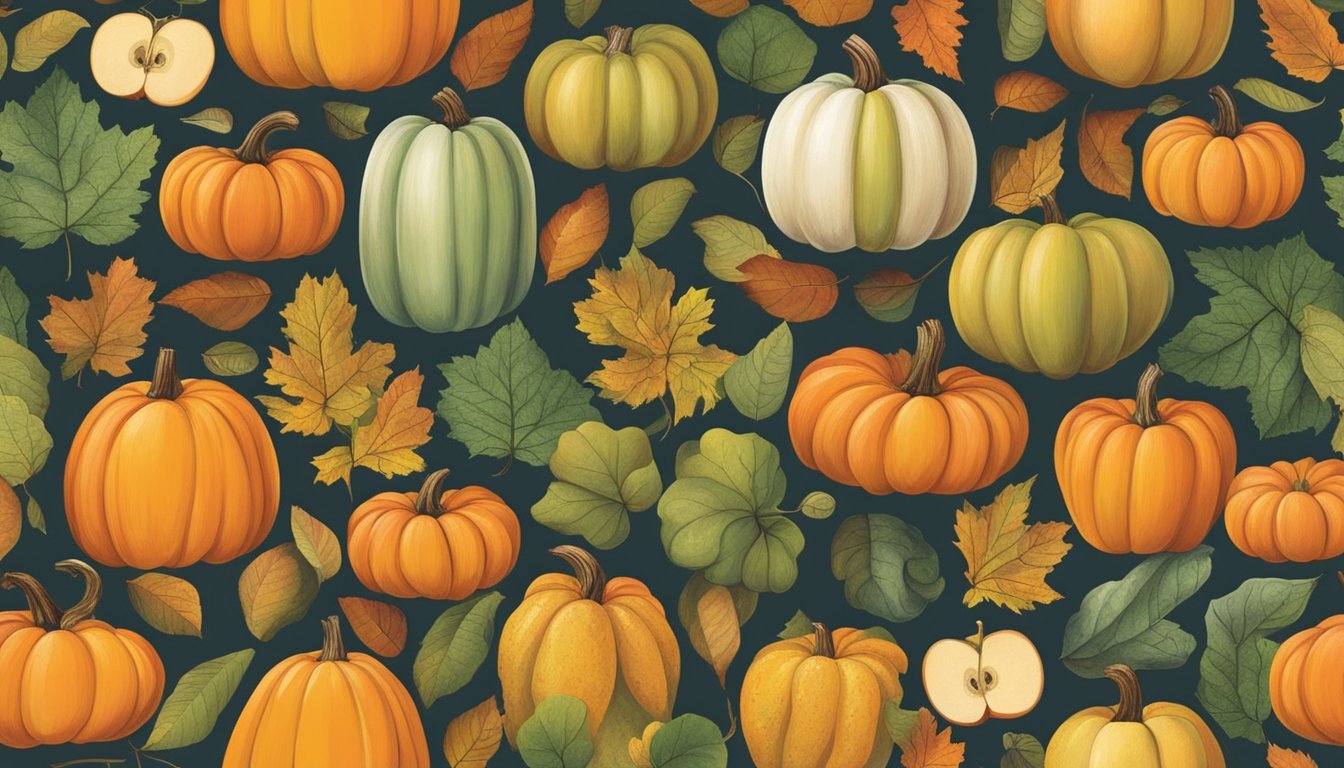Washington Seasonal Fruit & Vegetables in October
Your Guide to Autumn Harvest
This Article is Part of our Washington Seasonal Fruit & Veg Calendar
October in Washington heralds a time of vibrant transition and abundance in the agricultural calendar. During this month, the state's diverse climates, from the lush greenery of the Pacific coast to the arid eastern regions, contribute to the harvest of a rich variety of fruits and vegetables. Farmers and gardeners across Washington meticulously gather the fruits of their labor, ensuring that local markets are brimming with fresh, seasonal produce. The cooler weather ushers in the final wave of apple varieties, each with its unique flavor profile and culinary uses, from crisp, fresh eating varieties to those best suited for baking.
The state's produce is not limited to apples (how long do apples last?) alone; pears, such as the Anjou and Bosc, also reach peak ripeness and become widely available. They offer a sweet, slightly floral taste and a buttery texture that can enhance both sweet and savory dishes. Root vegetables, like beets and carrots, start to take center stage, offering earthy flavors (What wine goes well with earthy flavors?) and hearty textures that are well-suited for autumn's warm stews and roasted dishes (What wine goes well with roasted dishes?). Meanwhile, greens such as kale and Swiss chard thrive in the cooler temperatures, offering a nutrient-rich addition to meals.
On the vegetable front, Washington's October offerings include a variety of squashes, pumpkins, and gourds. These seasonal favorites not only symbolize the fall season but also provide versatility in the kitchen. From sweet pumpkin pies to savory butternut squash (how long does butternut squash last?) soups, the possibilities for culinary exploration are extensive. Home cooks and professional chefs alike take advantage of this time to create dishes that reflect the essence of the season, relying on the flavor, freshness, and nutritional value that Washington's October bounty provides.
Understanding Seasonality
In the Pacific Northwest, seasonality defines not only the availability of produce but also its flavor and nutritional value. Consumers and chefs alike turn to the rhythm of the seasons to guide their choices, favoring items at their peak.
Why Seasonality Matters
Seasonality is crucial for a multitude of reasons. Fresh produce in season tends to be at its peak flavor and nutritional content. It also supports the local economy and reduces environmental impact due to shorter transportation distances. In October, as summer transitions to fall, Washington's produce offerings shift, presenting a new range of flavors and ingredients.
Freshness: Seasonal produce is often harvested at peak ripeness, ensuring maximum freshness.
Sustainability: Locally sourced, in-season items generally demand fewer resources for transportation and storage.
Community: Buying seasonal goods supports local farmers and producers, fostering a connection between consumers and their food sources.
October's Seasonal Timeline
October marks the heart of fall, bringing a bounty of fruits and vegetables that thrive in the cooler temperatures. Apples and pears are quintessential fall fruits, celebrated for their versatility and storability. Root vegetables like beets and carrots, along with squash varieties, are also plentiful.
Fall Fruit: Apples, pears, and late berries contrast the fading sweetness of summer fruit.
Vegetables: Root vegetables gain prominence, offering hearty flavors for warming dishes.
October Seasonal Produce Apples Pears Pumpkins Winter Squash Beets Carrots Kale
These crops demonstrate the rich agricultural diversity of Washington, thriving across various growing conditions within the state. Consumers often plan meals around these staples, relishing the deep, rich flavors unique to the season.
Key Seasonal Fruits in Washington
October in Washington is a prime time for a variety of fruits. Orchards and markets brim with fresh, locally-grown produce offering a range of flavors from the crisp sweetness of apples and pears to the tartness of cranberries.
Apples and Pears
Washington is renowned for its apples, with varieties such as Fuji, Gala, and Honeycrisp widely available in October. These fruits are known for their crisp texture and sweet to tart flavors, making them perfect for both fresh eating and baking. Pears like Bartlett and Comice also reach their peak, offering juicy and buttery options for consumers.
Cranberries and Grapes
Cranberries are harvested in the fall, and in Washington, October is the time when they start to appear fresh in markets. These tart berries are typically used in sauces and baked goods. Grapes, including Concord and table varieties, can also be found. They are versatile, enjoyed fresh or used in recipes like jellies and juices.
Plums and Quince
The tail end of the season sees plums in Washington, with varieties that are juicy and perfect for snacking or making preserves. Quince is a lesser-known fruit that becomes available in October, characterized by its pear-like shape and astringent flavor, which is best enjoyed when cooked and used in dishes like jams, jellies, and pies.
Key Seasonal Vegetables in Washington
In October, Washington’s harvest is rich with a variety of seasonal vegetables. They focus on hearty pumpkins and winter squash, nutrient-dense root vegetables, and a diverse array of leafy greens and brassicas.
Pumpkins and Winter Squash
Washington yields an abundance of pumpkins and winter squash in October. These vegetables are not only staples for fall decorations but also offer a sweet, nutty flavor that is perfect for soups, pies, and roasted dishes. Among the most popular varieties are the classic orange pumpkins used for carving and baking, as well as butternut, acorn, and spaghetti squash.
Root Vegetables
The cooler temperatures in October are ideal for the growth of a range of root vegetables. Wa State is particularly great for potatoes, a staple in many diets, and offers a selection of native varieties. Other root vegetables, such as beets, parsnips, and rutabaga, also thrive during this time of the year, offering earthy flavors and a variety of textures that enrich autumnal meals.
Leafy Greens and Brassicas
Washington's farms produce an assortment of leafy greens and brassicas that are in their prime in October. This includes kale and chard, which are known for their resilience in cooler weather and their versatility in the kitchen. Additionally, Brussels sprouts (how long do brussels sprouts last?) begin to peak this month, bringing a slightly bitter but savory component to dishes that is often enhanced when roasted or sautéed.
Farmers' Insights
This section offers a glimpse into the agricultural practices and regional farming framework that contribute to Washington's abundant October produce.
Local Farming Practices
In Washington, farmers employ a mix of traditional and innovative methods to cultivate a variety of fruits and vegetables during the fall season. They rely heavily on crop rotation and integrated pest management to maintain soil health and control pests, respectively. Crop diversity is a key strength, allowing farms to produce a range of fruits and vegetables that are in peak condition in October.
Fruits typically harvested in October:
Apples: Fuji, Gala, and more
Pears: Bosc, Anjou
Blackberries: harvested into mid-October
Vegetables ready for harvest:
Pumpkins
Sweet corn
Various types of squash
Washington's Agriculture Profile
The state's agriculture extends beyond just the farm. Washington's farmers contribute significantly to the local and state economy, utilizing over 15 million acres of land for agricultural purposes. The state's diverse climate, ranging from temperate in the west to arid in the east, supports a variety of crops.
Key Produce Areas:
Yakima Valley: Renowned for apples, pears, and hops.
Skagit Valley: Known for potatoes, tulips, and berries.
Palouse: Famous for its wheat and legume production.
Washington's farmers harvest not only a significant amount of the nation's apples but also potatoes, stone fruits, and berries, standing out as a cornerstone of local and national produce supply.
Seasonal Dishes and Preparations
In Washington during October, fresh produce inspires a variety of dishes, from sweet preserves that capture the essence of the harvest to heartwarming roasted vegetables that complement the cooling weather.
Salads and Raw Dishes
Salads in October benefit from the fresh crunch of local apples and pears, which can be paired with roasted pumpkin seeds (how long do pumpkin seeds last?) for a nutty contrast. Sliced raw sweet potatoes bring an earthy sweetness and can be incorporated into slaws or salads, dressed lightly with a vinaigrette made from apple cider–a staple of the region's fall harvest.
Roasting and Grilling
Roasting transforms the hearty root vegetables of Washington into caramelized, comfort-filled dishes. Sweet potatoes and cauliflower are particularly suited for roasting; they can be tossed in olive oil, seasoned with sea salt (how long does sea salt last?), and roasted until they develop a crispy edge. One can also grill to add smoky notes to the sweet flavors of corn and chiles, which are still available in October.
Jams and Preserves
Fall is the perfect time to create jams and preserves, ensuring that the flavors of the season last into the colder months. Berries might be fading, but one can still use the last of the harvest or embrace late-season fruits like pears. When simmered with sugar and perhaps a hint of lemon for balance, they become a delightful jam to spread on morning toast or to complement cheeses.
Buying and Storing Tips
When purchasing seasonal fruits and vegetables in Washington during October, one must be discerning to ensure freshness and quality. Proper storage is equally critical to maintain the integrity of the produce until it's ready to be consumed.
Selecting Quality Produce
To secure the freshest and highest quality produce, always look for fruits and vegetables that are firm to the touch and free of bruises or blemishes. For example, broccoli should have a bright green color and firm stalks, as it is one of the freshest vegetables available in October. If available, opt to buy from local markets since the produce is often picked at peak ripeness and hasn't traveled far, retaining more of its nutritional value and flavor.
Storage and Preservation
Once you've bought your fresh produce, correct storage is vital to extend its shelf life while maintaining its taste and nutritional content.
Fruits: Most fruits do best when stored in a cool, dark place or in the refrigerator. For berries, such as blackberries which are harvested up to mid-October, line the container with paper towels to absorb excess moisture and prevent mold growth.
Vegetables: Vegetables like broccoli should be stored in the crisper drawer of the refrigerator to keep them fresh longer. Avoid washing vegetables until right before you use them, as moisture can hasten spoilage.
For both fruits and vegetables, if you plan to store them for more than a few days, consider using airtight containers or freezer bags to prevent air-induced decay. Remember that some fruits emit ethylene gas which can cause nearby ethylene-sensitive produce to ripen prematurely. It's advisable to store such fruits separately.
By following these tips, consumers can enjoy delicious and nutritious snacks and meals from their carefully selected and stored Washington seasonal produce throughout October.
Health Benefits and Nutrition
October in Washington is abundant with a variety of fruits and vegetables, each with significant health and nutritional advantages. Consuming fresh, seasonal produce ensures that individuals receive optimal nutritional value due to reduced time between harvest and consumption.
Fruits such as apples and pears are harvested during this time and are rich in dietary fiber, which promotes digestive health. They also contain vitamin C, essential for boosting immunity. Cranberries are also in season and offer a wealth of antioxidants, known for their anti-inflammatory properties.
Vegetables like pumpkins and sweet potatoes are excellent sources of beta-carotene, which the body converts into vitamin A, vital for vision health and immune function. These vegetables are hearty and dense in nutrients while being naturally low in calories, supporting weight management and overall health.
Here is a concise list of nutritional highlights of Washington's October produce:
Produce Key Nutrients Pumpkin Vitamin A, Fiber, Antioxidants Sweet Potato Vitamin A, Vitamin C, Manganese Apple Dietary Fiber, Vitamin C Pear Fiber, Vitamin C Cranberries Vitamin C, Manganese, Fiber
Consuming these foods shortly after their harvest can enhance their nutritional profiles. The freshness not only contributes to superior taste but also to the preservation of vitamins and minerals often lost with prolonged storage. Including a variety of these fruits and vegetables in one's diet may help decrease inflammation, cleanse the liver, and boost immunity.
Furthermore, studies suggest that seasonal plant foods can contribute to increased circulation, which is pivotal for cardiovascular health. The fresh produce of Washington in October offers a natural palette of health-enhancing nutrients beneficial for any balanced diet.
Monthly Produce Guide
In October, Washington's harvests offer a diverse selection of fruits and vegetables. Shoppers can find the freshest produce by knowing what is expected to be in season during the early, middle, and late parts of the month.
Early October Produce
Early October brings the tail end of summer crops while transitioning to fall varieties. Shoppers can find:
Fruits: Apples (varieties like Gala, Honeycrisp), Pears (such as Bartlett and Bosc)
Vegetables: Kale, Potatoes, Pumpkins
Mid-October Harvest
By mid-October, the seasonal shift is noticeable as cooler-weather produce becomes more prominent. Available items include:
Fruits: Cranberries, Concord Grapes
Vegetables: Brussels Sprouts, Carrots, Wild Mushrooms
Late October Variety
As October ends, the variety of produce available reflects the full swing of fall. Consumers should look for:
Fruits: Persimmons, Pomegranates
Vegetables: Beets, Winter Squash (e.g., butternut, acorn), Turnips
Environmental Impact
Washington's seasonal fruits and vegetables in October have a noticeable environmental impact. They support sustainability by reducing the carbon footprint associated with long-distance transportation. Local seasonality, which reflects the harvest times in Washington, is a key aspect of sustainable agriculture and enhances ecological balance.
Local farms practicing sustainable growing methods produce a variety of fruits and vegetables in October. For instance, apples and pears are typically harvested. Sustainable practices might include crop rotation, water conservation, and using organic methods that limit chemical inputs.
Reduced transportation distances for locally grown produce result in lower greenhouse gas emissions. This is particularly relevant for seasonal fruits and vegetables that are at their peak in October. On the other hand, fruit and vegetables sourced from far-off places consume more fossil fuels and resources during transportation.
In October, farmers' markets and community-supported agriculture (CSA) programs are typically abundant with a selection of seasonal produce. These programs minimize packaging and waste, contributing to the environmental benefits of consuming locally and seasonally. For example, less packaging translates to reduced plastic waste, thus benefiting the ecosystem.
The life cycle assessments (LCAs) of local seasonal produce often show a lower environmental burden compared to non-seasonal or imported produce. The LCAs take into account the entire life cycle of the product, from cultivation to consumption.
In conclusion, the environmental impacts of consuming seasonal fruits and vegetables in Washington during October are predominantly positive. These impacts foster a sustainable and ecological approach to food consumption, aligning with a commitment to environmental stewardship.











